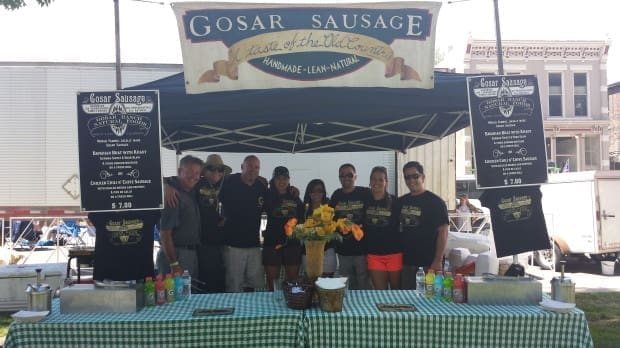One Colorado mountain town has a sign between the post office and their one tavern that reads - "On this site, September 15, 1890, nothing happened.' Good humor, though something had to have happened, if for no other reason than someone was there to document that nothing happened.
From the western movie The Man Who Shot Liberty Valance—a story about the fictitious town of Shinbone coming of age in an unnamed western state over many years—an eastern newspaper reporter and his editor listen to Jimmy Stewart recount his journey as a young lawyer in the territory and how he came to serve as governor, then become a US Senator for several terms and become a vice presidential candidate. The turning point early on in his career, which led to his fame, had been a gunfight where he shot and killed Liberty Valance, one of the stereotypical bad guys that stood in the way of progress in our western territories. When Stewart's character recounts that the shooting was not all his doing, the editor states matter-of-factly that "This is the west sir, when the legend becomes fact, print the legend."
What does this have to do with Fort Garland, Colorado? Historical facts and legends have passed through Fort Garland. But history in the west in the 1800s has been skewed, skewered, shrouded, and exaggerated and in the process, created legends and making historical facts less than accurate.
Forts have been a part of westward expansion since Europeans hit the eastern shores of the United States. Forts became homes to soldiers and settlers and a place for protection from 'bad elements,' whether it was American Indians having to attack a fort to protect what they believed to be their territories and livelihoods, or, it was often foreign countries in political struggles with new Americans fulfilling the loose, misunderstood, and controversial concept of 'manifest destiny,' whereby American Settlers believed they had the right to expand the new country all the way to the Pacific Ocean. Which meant overrunning Indian tribes and moving the survivors to reservations, fighting with Mexico and booting out claims by France, Britain, Russia, and Spain. In perspective, New Mexico and Arizona were still territories and not states until 1912. Fort Garland opened in what was then the territory of New Mexico until 1861 when the Colorado territory was created.
Forts began in the San Luis Valley when Fort Massachusetts was built in 1852, six miles north of the present day town of Fort Garland. Built of wood and located next to Ute Creek, Fort Massachusetts proved to be too swampy and isolated to help settlers in the valley, and too vulnerable to attack from the Ute Indians who were not happy about their valley being invaded. By 1856, a new fort was planned and being built. Occupied in 1858, Fort Garland was built with adobe, as the local Hispanic populations had been using adobe successfully from New Mexico northward. As artisans of the craft of adobe construction, they were recruited to help build the many buildings that became Fort Garland.
Fort Garland's role in American History became significant for several reasons. I am lucky enough to have two ancestors who wrote diaries. My great great grandfather served the Union in the 30th Iowa infantry division. He enlisted in August of 1862. Earlier that year in the month of March, the Confederacy, in an attempt to help fund the war effort against the Union, sent an army up the Rio Grande Valley through New Mexico territory from El Paso, Texas toward the gold mines in present-day Colorado. Two-hundred Union Soldiers stationed at Fort Garland made a cold snowy trek south through the mountains to aid other Union Forces in stopping the Confederates. The Union was successful at the battle of Glorieta Pass east of Santa Fe. The Confederates were stopped from ever reaching gold and they were stopped well short of another goal of securing the southern parts of New Mexico, Arizona, California and the port of San Diego, and making all of that strategic land part of the Confederacy. Had the Confederacy been able to secure those goals and fund the war effort, the US might not be a united country. My great grandfather fought to take Vicksburg, Chattanooga, all the battles for Atlanta, and go on Sherman's (Uncle Billy they called him) March to the Sea. Had the South been able to secure more resources, Union Soldiers would have faced perhaps, a very different, well supplied army.
My great grandmother, as a young girl, was moving to the midwest from the East coast in July of 1863 and passed through Gettysburg where two weeks earlier, yes, the Battle of Gettysburg took place. Her grandmother had hidden in the cellar for three days and when she emerged after the battle, she found three unexploded cannonballs lodged in her house. My great grandmother became a Methodist missionary in the fall of 1887 and was sent to Tucson. Had Arizona become part of the Southern Nation, northerners may not have been allowed. So Fort Garland has played an indirect role in my history. NOTE: I make reference to Southern Nation as I had been to a 150th anniversary battle reenactment in Resaca, Georgia (battle took place in May of 1864) in which my grandfather fought and I talked to a southern re-enactor. He was wearing a US brass belt buckle upside down. He told me that Confederates would strip dead Union soldiers of their buckle and wear it upside down for Southern Nation. A US belt buckle is on display at Fort Garland museum.
Fort Garland played another critical role one year after the battle of Glorieta Pass preserved the West for the Union. Beginning in March 1863, people in the nearby valleys and the SLV were being murdered for no explainable reason. The bodies were also being mutilated. Finally, after one attack, one person was able to escape and identify the killers. Felipe Espinoza, his brother, and a cousin were carrying out the murders to avenge deaths of relatives and because they felt that their lands which were Spanish Land Grants recognized by the United States Government were stolen or squatted upon illegally. As the story (legend?) goes, Felipe Espinoza had been a child in Vera Cruz Mexico during the Mexican War of 1846-1848. The US Navy spent several days shelling the city from the Gulf of Mexico and when Felipe had been away, six members of his family had been killed in the shelling. Escorted by a nun, a young Felipe had to identify the badly mutilated bodies of his family which later manifested into a killing spree of his own, vowing to kill 100 anglos for every family member, including the governor of the Colorado Territory at the time!
Soldiers from Fort Garland were on the hunt for the Espinozas but their efforts proved unsuccessful until the commanding officer at Fort Garland recruited Tom Tobin, whose history parallels Kit Carson in his abilities as a trapper, a scout, a fighter, and bounty hunter. Tobin was able to track down the Espinozas in October of 1863 and put an end to the killing spree. (Tobin's daughter married Kit Carson's son.)
After the war, Kit Carson became the commanding officer at Fort Garland in 1866-67 before retiring for health reasons. He died a year later but leaves his legend, legacy and name on many things; a town, a mountain, a National Forest, a county, etc. His life and legend had been highly inflated by the dime store novelists at the time who were giving readers in the East nearly unbelievable tales of Carson's adventures in the West. Though he had done his share of Indian fighting, he was instrumental in helping the Utes make an attempt at peace with the settlers and miners moving into the San Luis Valley in large numbers. The history in the San Luis Valley in the 1870s became a serious clash of cultures. After Carson and Chief Ouray of the Utes died, and with the continued inflow of people, peace between the two groups eroded.
By 1876, African American soldiers of the 9th and 10th Cavalry divisions were stationed at Fort Garland. They had the difficult duty of trying to get the Ute Indians onto reservations. The Buffalo Soldiers were a mixed group of free blacks who had fought in the Civil War and those who joined the army after the war to receive an education, develop stronger self images, and live a life in the Army that was better than the life from which they came. Segregation was reality as was the prejudice they faced, but history shows they were good soldiers. Apparently the name Buffalo Soldiers came from the Indians with whom they had to fight and interact. Indians could see that the Buffalo Soldiers were fierce fighters and in a term of respect, considered them fighters like wild buffalo. Also, the curly African American hair reminded them of the hair between the horns on the buffalo. The name Buffalo Soldiers stuck.
A visit to the Fort Garland Museum helped me to understand the westward expansion of the US a lot better, painting a vivid picture of the fort's role. The museum is just south of Highway 160 on Highway 159. And though, in its 25 year history, when in 1883 the railroads were moving in and the fort was no longer necessary, there were 'boring' days when not much happened besides staying warm in the winter, feeding the horses, going through drills, and performing other soldier duties, Fort Garland played an important role in history.
If passing through Fort Garland, there are no excuses not to visit the Museum. Buildings have been restored and each one is its own museum, whether it be the Buffalo Soldiers' quarters or the Civil War building. An extensive bookstore/gift shop has hundreds of books on the history of those interesting times. Hungry for more? Internet search for - Fort Garland CO, Kit Carson, Tom Tobin, Felipe Espinoza, Ute Indian tribes in Colorado, Manifest Destiny, and the book, Guns, Germs and Steel by Jared Diamond (a fascinating book on European expansion of cultures and why they had advantages over others, including one 'accidental' advantage of disease - which may have killed up to 95% of the Indian tribes Euros encountered), and the Battle of Glorieta Pass. Start with those, which should occupy most of a rainy day when otherwise you might be doing 'Nothing.'










